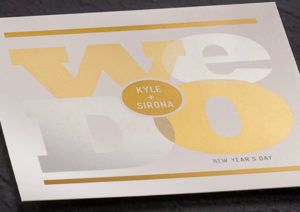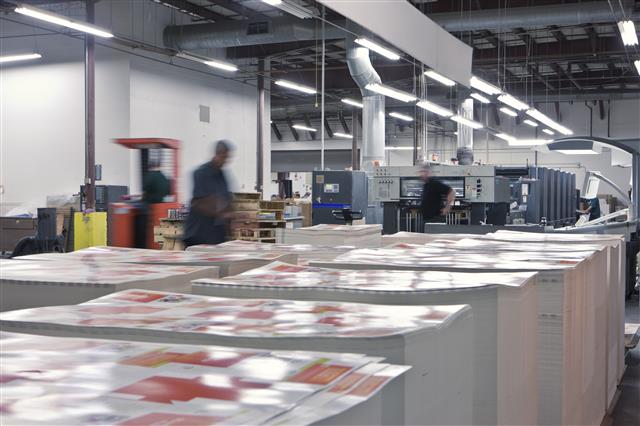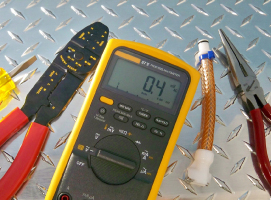If your goal is to capture more work from today’s print-embracing marketers, your current sheet-fed digital press might not be up to the quest. Brands and businesses want direct mail, invitations, packaging and other pieces that earn maximum impact for their marketing spend, and when you bring these value-add capabilities to the table, you benefit handsomely. Print service providers’ profit margins on digital print enhancement can be high (50% to 400%), resulting in a quick return on investment (ROI)1 — for printers with the right equipment.
To take advantage of growth like this, you need a system that clearly stands out in areas like running at rated speed, actual uptime, specialty inks and extra long sheets. This article covers these plus 10 other checkpoints that need close attention in order to make your best cut-sheet digital investment.
1. Does the press give you a competitive advantage through metallics and other specialty inks?
Digital print enhancement is predicted to grow at 27% CAGR from 2015 to 2020, reaching 25 billion pages by 2020.1 Marketers are intrigued by the results they get from specialty inks and longer sheets (some up to 47.2”!) They want shorter, more complex jobs, and press technology exists today that can deliver that kind of work faster and at a good price point, too.
It’s important to understand how sheet-fed presses differ. Some systems bring white dry ink and extra long sheets up to 47.2″ (1.2 m) that give you more options for the work you can take on. If it’s been some time since you last got a digital press, your choices have improved greatly, and you can’t have the same old discussions. It’s a new world, and it’s pretty exciting.
In 2018, the print industry was introduced to the first sheet-fed digital platform for single pass; six-color; mixed metallic, clear, gold and silver embellishments. A further advantage is that the output comes off the press dry and ready to be finished. Neither offset nor traditional cut-sheet presses can do this.
The sparkle of silver and gold metallics delivers real value. Marketers and print buyers will pay a premium of 24% to 89% for digital print enhancements over CMYK only printing.1 These jobs also cost less because of operational and productivity savings from automation.
2. What makes better four-color output? Look to the toner particles.
What really makes one color outcome different from another? It gets technical as well as subjective. When you explore sheet-fed systems, learn about their toner chemistry and the particles that go into it. Did you know that one of the smallest ink particles in the industry is 4.7 microns? It makes sense that a very fine particle creates ultra-high definition resolution for outstanding color quality.
If you really want to get your toner geek on, check out this white paper on Emulsion Aggregation (EA) toner.
3. How to compare sheet-fed digital presses by productivity and speed.
Sometimes just by looking at productivity alone, you soon see that one press becomes the clear choice. Think about these scenarios:
- One sheet-fed press offers 1,000 4/4 color, 12”x18” sheets per hour.
- Another vendor’s sheet-fed digital press not only runs 4/4 at rated speed, but even 5/5 and 6/6 color on 12”x18” sheets at 1,800 sheets per hour.
So one system is actually faster when running four, five or even six colors than the other press is just running simple four-color work!
But that’s not the only way to think about speed.
4. Will the press maintain its rated speed, even with six color stations?
Prepare to drill into the specifics of press productivity with questions like this one: Will the number of colors affect the press’s rated speed, or will it slow down the more stations in use? Ask your vendor how they handle this scenario. When you run four or more colors on a particular press (assuming it can handle them) how do additional colors affect running speed? The answer you want is, “Not at all. The press maintains its productive rated speed of 120 ppm even at six colors.”
Look for a six-station press that maintains its rated speed whether you’re running 4,5 or 6 colors to get the most profitable output on the other end. Less waste, less labor intervention, less re-work = better economics.
5. How will uptime affect speed on a sheet-fed press?
Now let’s bring uptime into the speed story. Say you get 65% uptime on that “1,000-sheet” job mentioned above, so now you’re down to 650 12”x18” 4-over-4 sheets per hour. That’s right, 650, OUCH! Compare that to uptimes of 85% that are possible on some six-color systems. That gives you 1,530 12”x18” sheets per hour regardless of how many colors. Basically 2.5 times the productivity! With just a little probing, you can get to the specifics of what speed and uptime mean for a particular press.
Remember to look for capabilities that take human steps out of your workflow. Can automation and easy-to-use features give you better uptime? Tools like EZ Press Check and Side Guide minimize human intervention needed to run a cut-sheet digital press. All these things add up to more uptime and more money in your pocket. If you’re not printing, you’re not making money. Bottom line.
6. Who’s running the show? Digital press operators and automation.
Can automation and easy operation give you more consistent uptime on your current sheet-fed press? Or are you stuck with a system that needs an expensive operator to catch mistakes and keep things going? Even with the best operator, you might still net just 65% uptime.
Your next sheet-fed press should give you speed, bandwidth, better automation and better color, all with the simple click of a button.
7. Don’t buy a “science experiment”
Don’t invest in a product line that could become a “science experiment” to maintain. That is, will it require a costly upgrade or a new platform altogether to add revenue-boosting capabilities? That becomes a very expensive experiment, especially if you’re already near the end of a lease.
8. Compare print samples.
No one would buy a press without looking at samples, so if that’s already on your list, ask your vendors for samples of specialty inks and different page sizes. These areas have seen great progress, so you have more to see. Not every vendor can handle metallics, much less mixed metallics and other specialty inks, so see for yourself.
Don’t settle for just any dry white ink either. Compare output samples to see the real difference. You’ll find a range of quality levels available to you. Ask your vendor how many passes of white it took to achieve that quality. If it’s more than one, then it’s too many. In the same vein, make sure you see mixed metallic ink samples. Some vendors can’t do that at all. Look closely at the output as you make your digital press choices.
9. Watch for and avoid these weaknesses in a sheet-fed digital press:
- Validate EPM quality is what it is claimed to be.
- How many passes does white require? On some devices, it takes four hits of white to match what others can do in one. On some presses, it just takes one pass for six colors, including white.
- Will the press slow down – possibly as much as 25% — on every hit of a fifth and sixth housing? Some systems can be slow even in the 4/0 printing
- How long between loading sheets? It’s worth doing your homework, because some six-color, single-pass presses can load many thousands of sheets more at a time. The Iridesse press, for example, can load 7,300 sheets at a time, while other models only load a maximum of 5,200 12”x18” sheets
- What about sheet size flexibility? Some systems max out at sheets to 13”x19” at the high end and can’t run 11”x17” due to wear lines. If that matters to you, bring it up.
- Don’t settle for low uptimes like 65%. Ask your vendors. Some may be able to deliver uptimes closer to 85%.
- Watch out for significant costs for an operator to run the sheet-fed press. This is avoidable through automation and productivity features. Significant productivity hits for maintenance (PIPs, BIDs, flushing ink lines, laser writer) should be red flags.
- Multiple points of image transfer could be an issue. Ask your potential vendors about their approach.
- Have a discussion about drying and ink permanence
10. Look for productivity features like these on a sheet-fed press:
- Full width array (profiling, calibration, IOP, color)
- Productivity and rated speed on mixed media (.5mm FTB registration)
- Belt fuser for quicker recovery on mixed media
- Paper stock library to give users more control
- Easy press check using automation
- Auto-duplex 400 GSM up to 28.7 inches
- Up to 47.2” sheet printing
11. Explore quality features like these in discussions about your next sheet-fed press:
- Ultra high definition resolution for better color
- 1200x1200x10 bit ripping
- Low melt emulsion aggregate toner
- Full width array (profiling, calibration, IOP, color, second bias transfer)
- Mixed metallic hues
- Superior white dry ink
- 4, 5 and 6 color stations
- Fine 4.7 micron toner for quality on tough media
- Gold, silver and clear embellishments
12. What inline sheet-fed feeding and finishing features do you need?
What feeding choices are available to allow longer, uninterrupted runs and more uptime? Both basic and more advanced solutions exist. Choose what helps you take on more types of margin-friendly inline finishing jobs using built-in options for speed, automation and productivity.
13. What does benchmark automation look like for sheet-fed digital printing?
The more you learn about printing automation the better. Automation results in less human intervention and continuous accruals of productivity improvements. The typical automation on many installed systems has been surpassed lately by new innovation and expansions, so ask about the latest capabilities available on presses you’re considering.
By adding productivity and efficiency, press automation pays you back in ways that translate into financial value. You gain more available employee hours when the team doesn’t have to worry about time they currently spend:
- Adjusting front-to-back registration
- Wrestling with color
- Ensuring optimal lay down of dry ink on hard-to-print specialty media
All these tasks can be automated down to one click of a button, saving hours a day. Removing that cost from your business is worth significant money over the course of 1 or 2 shifts multiplied by days, weeks, months and even years.
The Right Sheet-fed Press for Your Business
If you’re already where you want to be with your current cut-sheet press, great. If not, use these tips and questions to find the right sheet-fed digital press for your best future. The press you seek is definitely out there. Look for a model with strong fundamentals and the chops for new applications. The 13 topics on this list should be part of your discussions with your vendors as you research sheet-fed digital press systems. If you follow these guidelines, you’ll find the choices will narrow down pretty quickly.
- Keypoint Intelligence-InfoTrends, “Beyond CMYK: The Use of Special Effects in Digital Printing,” 2016



